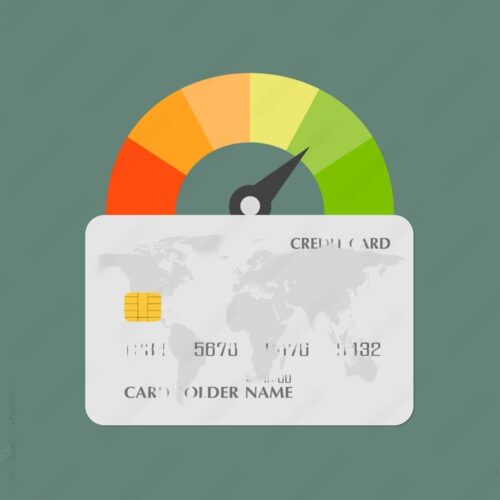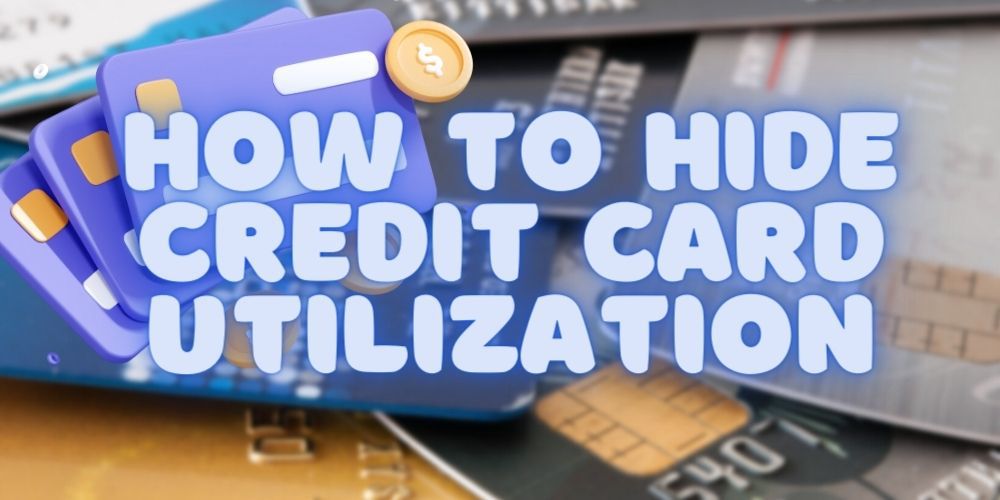The credit card utilization ratio is one of the most important factors that influence your credit score. Bringing it down can quickly improve your rating. But can you hide your credit card utilization? We provide the answers below.
What Is Credit Card Utilization Rate?
Credit utilization is a parameter used by lenders to assess a person’s ability to manage debt.
It also indicates how well they understand the lending system.
This ratio can be calculated by dividing the total balance across all available credit cards by the sum of the limits offered on each of them.
Utilization rate is among the five factors that make up the FICO score.

It has a 30% weightage in the calculation.
The other metrics include payment history (35%), length of credit history (15%), credit mix (10%), and new credit (10%).
A good rule of thumb regarding the utilization ratio is that it is best kept under 30%.
Can I Have 0 Utilization?
Yes, if the entire balance is paid off before the due date, your report will show zero utilization to the credit bureaus.
However, there is no particular advantage in doing this.
Even if all payments are made exactly on the due date, lenders will always see some balance against your name.
But as long as the money is deposited within time, credit scores will not be impacted.
Moreover, as long as the utilization rate is under a reasonable limit (30%, for example), credit card companies will not penalize it.
What Is the Average Utilization?
The average utilization is calculated as the sum of all of a person’s credit card balances divided by the total credit limit across them.
For example, let us suppose that an individual has three cards.
In a given month, the credit card balance on the first one was $500, with a limit of $1,000.
The second remained unused but had a credit allowance of $700.
The third card was used most heavily.

It carried a balance of $1,500, as against a maximum approved limit of $2,000.
The utilization ratio in this case would be calculated as follows:
($500 + $1,500 + $0)/($1,000 + $700+ $2,000) = 54%
Most experts would consider this as too high.
If it consistently remains more than 30% for a few months, the cardholder’s credit score might get impacted.
In the next section, we talk about how one can avoid this.
Can I Hide My Utilization on My Credit Report?
It is not possible to hide one’s utilization rate on their credit report.
However, there are ways to reduce it over time.
Some simple tricks and good old financial discipline can help to bring it to an acceptable level.
Doing so will not only improve the credit report but also make it easier to get loans and other forms of debt later on.
How Do You Fix High Credit Utilization?
Here are five simple ways in which overall credit utilization can be significantly brought down in a short time period.
Regular and Frequent Balance Payments
Ideally, the credit card issuer should report all balances at the end of each one’s billing cycle, but that’s not always the case.
Sometimes, they might share the information of all their customers with the credit bureaus simultaneously.
Hence, paying in full on the last day of the billing cycle may not always be the best idea.
Instead, frequent, small payments made quickly after each purchase can keep reported balances low.
Alternatively, it is possible to determine when the reporting happens by contacting the customer care of the credit card company.
Then you might make a payment before the date that they inform you.
However, this may shift in the future without any communication with you.
Therefore, the first method is preferable.
A simple way to execute this strategy is to decide on a (lower) limit for yourself.
Whenever it is reached, you should pay off the balance that has built up immediately.
For example, if the card issuer has offered a maximum credit of $1,000, you might set up an internal limit of $200.
Whenever the $200 barrier is breached, pay up in full.
This way, the utilization reported will always be below 20% ($200/$1,000).
Moreover, one should avoid using credit cards for any sort of long-term debt.
If it is impossible to do so due to a personal emergency, try to use a card with a 0% APR offer for a few months on it.
Get a Higher Credit Limit
This is a simple trick to reduce one’s credit utilization rate.
Unfortunately, the cardholder needs to have a good credit score to do it.
There are two ways to get an increased limit:
- Get a new card
- Ask your issuer to enhance the existing value.
In either case, easy access to more credit should not become an invitation to spend higher.

A higher limit will work only if additional spending is controlled.
For those whose credit management skills are not good, this idea can backfire very badly.
They might end up with even higher credit card debt than before.
Hence, it is important to weigh the pros and cons carefully before attempting it.
Moreover, there are many factors to consider in both the methods that we mentioned.
We discuss them below in detail.
Get a New Card
By doing this, the total available credit goes up.
That, in turn, immediately brings down average utilization.
However, it is important to remember that a new application always entails a hard inquiry on the credit card account.
This can temporarily bring down your score even before there is any benefit from lower utilization.
Moreover, a new credit line reduces the “length of credit” parameter.
This is also an important part of the FICO score.
As mentioned earlier, it has a 15% weightage (though not as high as the utilization rate, which accounts for 30%).
Again, how much additional credit will become available through a new card is subject to various factors.
Some of these might include income and credit history.
Higher Credit Limit on Existing Card(s)
It is possible to ask your current issuer to increase your available limit.
What’s more, this would only entail a soft inquiry. Hence, it does not impact your score.
Neither will it hurt the average age of credit.
A request for a credit limit increase can usually be placed by contacting customer support or applying online.
However, whether it will be accepted or not depends on your payment history and other parameters.
Moreover, some issuers may place a minimum time limitation (such as six months) before they can extend more credit.
Cut Spending
This is perhaps the most deceptively simple way to keep credit utilization low.
Unfortunately, for someone struggling with high credit balances, it is easier said than done.
Here are some ideas on how you might attempt to reduce spending.
Make a Budget
Keeping tabs on income and expenditure has to be at the heart of any exercise to reduce spending.
A simple budget can be made using the below method:

Create a monthly statement of expenses and identify the essential ones (such as food, grocery, gas bills, etc.).
After this, decide a maximum limit for “superfluous spending” and track it closely.
The moment it goes above the budgeted amount, one should defer any further such expenditure for the next month.
Use debit cards instead
Debit cards can help cut down how much you shop because the amount gets deducted from your account immediately.
Firstly, this limits the spending to within your available means and does not allow overspending.
Moreover, psychologically, credit cards offer a safety buffer for repayment by offering a grace period.
This unintentionally makes expenditure seem like “tomorrow’s problem.”
Instead, debit cards make payments feel more “real.”
When the amount gets debited from the account each time, the spender is forced to consider whether the purchase is worth it.
Automate payments
At times, the problem might not be about money, but rather discipline.
Some people may find it hard to manage multiple credit cards.
If it is tough to keep track of due dates and balances, automating the task might be a good idea.
To do this, simply contact the customer support of your card issuer.
Ask them to auto-debit balances from your checking account each month.
Some companies also let customers apply for this online.
Do Not Close Older Cards
This step is not directly linked to utilization but is important to ensure a good credit score.
While reducing spending, many people think about closing their older cards to manage their debt better.
However, the length of credit makes up 15% of the FICO score.
Closing older cards can significantly impact this factor.
It might be better to keep them open and spend just enough to let them remain active.
Consolidate The Debt
Some credit card companies offer 0% APR cards with no interest to be paid for the first few months.
If it is possible to get one, transfer balances from other cards onto this.

Then, work towards paying off the remaining amount during the promotional period.
Will My Credit Score Go Down if My Utilization Goes Up?
Yes, a higher utilization rate can impact your credit score.
As explained earlier, this parameter weighs as much as 30% in FICO’s model.
It is a crucial factor in deciding the overall number.
Always try to keep the average credit utilization ratio below 30% to ensure a healthy score.
Will 50% Credit Utilization Hurt Me?
A 50% usage rate may not be good for your credit score.
As a rule of thumb, most experts recommend keeping your utilization below 30%.
Lenders prefer to see a lower percentage because it depicts your ability to use credit responsibly.
It indicates that your reliance on using debt for everyday purchases is not very high.
Hence, such a high value might impact your creditworthiness in their eyes.
Do Lenders Look at Utilization?
Yes, lenders consider utilization as an important parameter to assess whether and how much credit to offer you.
It constitutes nearly 30% of the FICO and 20% of the VantageScore credit score models, respectively.
As explained earlier, usage under 30% indicates a good understanding of the credit system and sound finances.
Anything higher than this is seen as a red flag.
Credit card companies and lenders may hesitate to offer further debt to the person.
They might feel that the facility will be misused.
Final Thoughts
The utilization rate is important when it comes to your credit report.
But there is no way to hide it from the credit bureaus.
What can be done is to systematically bring it down to an acceptable limit. Most experts agree that below 30% is usually a good ratio.
There are several ways to do it – from cutting down spending to adding new credit lines.
Each has its pros and cons.
Whichever method you choose, please remember that fiscal discipline and spending within means are almost always the best ways of keeping your credit scores healthy.


 Tags:
Tags:










